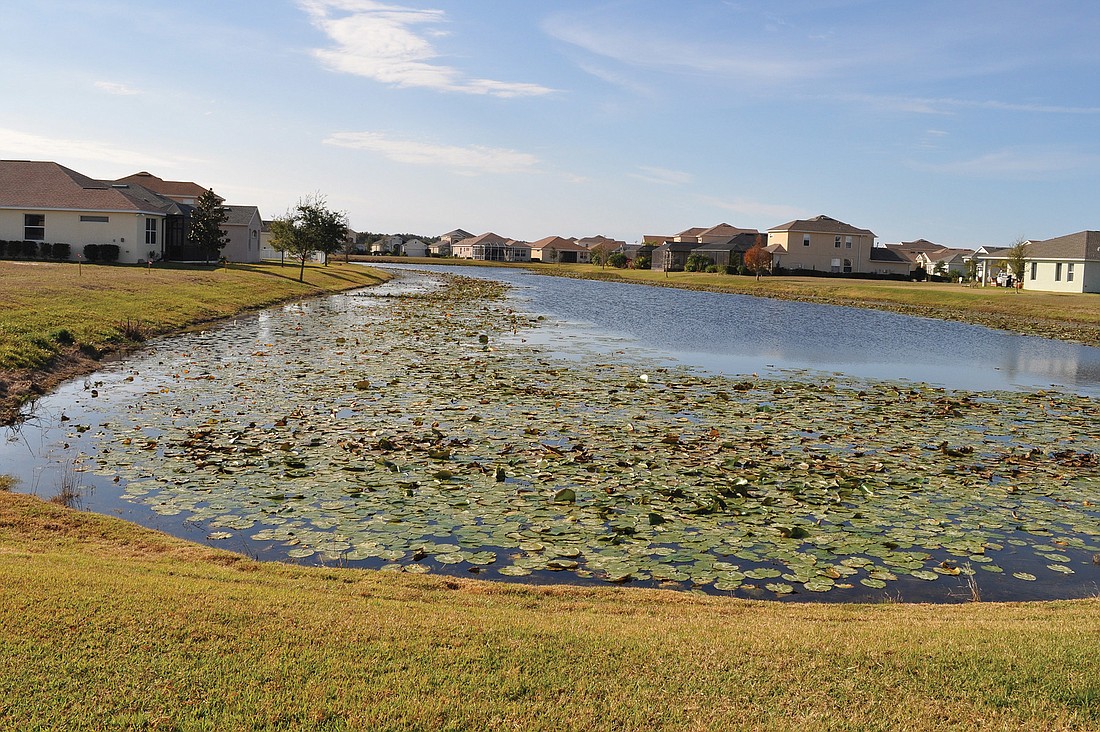- April 25, 2024
-
-
Loading

Loading

LAKEWOOD RANCH — As Rick and Milly Gonzalez step through their sliding glass door to a view of the lake behind their home in Greenbrook East, they shrug in exasperation.
Their lake view, they said, has become more of an eyesore than something they can enjoy. Lily pads, which once bordered the edge of the lake slightly, now extend more than 15 feet into the edge of the pond.
“The lily pads are overwhelming,” Rick Gonzalez said, noting guests have commented on pond’s poor appearance. “They look horrible. This lake, over the past five years, has gotten worse and worse.
“I didn’t buy into a swamp,” he said. “I bought into Lakewood Ranch. I don’t mind a couple of lily pads here and there, but this is insane. That’s our eyesore.”
Rick Gonzalez said he’s even more upset by the fact that other neighboring ponds are not covered with lily pads. And Lakewood Ranch, he said, has been unresponsive in addressing the issue, after several inquiries.
But the lily pads, Lakewood Ranch Town Hall officials said, are beneficial and will not be removed, as per Lakewood Ranch Community Development District 4’s lake maintenance policies. Those policies state the district will avoid damaging native plants and work to remove exotic and nuisance species through chemical and biological means.
“(The lake) is within the boundaries of (Community Development) District 4, and it’s maintained to the same standards as every other lake is,” Town Hall Director of Operations Ryan Heise said, noting the ecosystem within each lake is different. “Our standards are important. They’ve done as much as they can to make the lakes aesthetically pleasing.”
Heise said only one complaint regarding trash has been filed by the Gonzalez’s about the lake, and it is being addressed. Additionally, the Gonzalez’s lake has been inspected at least twice since mid-December, Town Hall reports showed.
In many ways, however, the Gonzalezes’ frustrations highlight a common issue in Lakewood Ranch and surrounding communities. Although homeowners often pay a premium for waterfront views, the primary purpose of the lakes on which they look is more environmental than aesthetic.
The lakes, which actually serve as retention ponds, are designed to capture runoff fertilizer and other pollutants before they enter the Braden River and water systems beyond.
Heise said native plants, such as lily pads, improve lake health by using runoff fertilizer and thus helping to prevent algae blooms and the growth of weeds, water discoloration and the release of toxins from sediment.
Lily pads, in particular, are common in shallow lake areas, he said.
Heise said Town Hall works hard to achieve the delicate balance between homeowners’ expectations for the appearance of lakes and the lake’s overall health and purpose.
“Sometimes those dynamics are very difficult (to achieve) and don’t match,” he said. “It’s really striking a balance.”
Heise said Town Hall Operations is working with the University of Florida to better understand the perceptions people have of plants in lakes and how to best educate the public about lake vegetation and its benefits.
Contact Pam Eubanks at [email protected].
MAINTENANCE FACTS
• Fertilizer and organic debris resulting from poor landscape maintenance practices are the primary reason for algae blooms in storm water ponds.
• Beneficial (native) aquatic plants produce oxygen and allow for the natural decomposition and/or utilization of excessive nutrients (from runoff fertilizer and other factors)
• Lakes without native plants are most aesthetically affected by algae growth because of fluctuating levels of nitrogen and phosphorous (found in fertilizers).
BENEFITS OF NATIVE PLANTS IN LAKES
Lakewood Ranch Town Hall Director of Operations said native aquatic plants play an integral role in maintaining the integrity of Lakewood Ranch’s ponds, streams and rivers.
Specifically, aquatic plants:
• Provide habitat and food for fish and other wildlife
• Provide a spawning medium for fish, invertebrates and amphibians
• Increase oxygen levels in the lake
• Stabilize temperature, light and ecosystem function within the lakes
• Recycle nutrients (from fertilizers and other runoff), helping to prevent unsightly algae blooms and the growth of unwanted weeds
• Slow the transport of sediment
• Help protect stream and river banks, lake and reservoir beds and shorelines